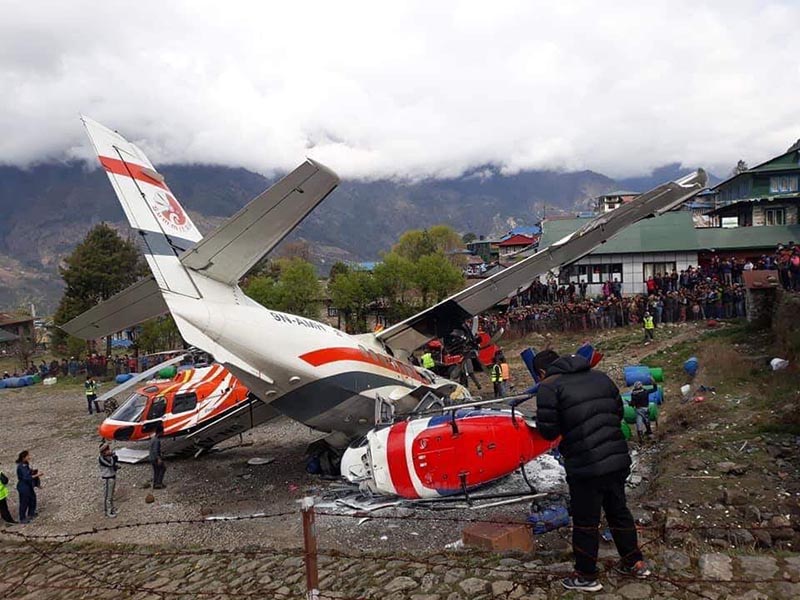Pilot-in-command failed to correct junior’s error
Kathmandu, April 15
Further disturbing facts are emerging about the circumstances in which the Summit Air LET-410 crash at Lukla claimed the lives of three persons yesterday.
Recording his statement to the probe team, senior captain Rabindra Bahadur Rokaya reportedly said he failed to immediately correct the wrong move taken by his first officer Sujit Dhungana during the take-off roll at Lukla airport.
Co-pilot Dhungana and two police personnel on the ground were killed when the aircraft veered off the sloping runway and collided with the parked helicopters nearby. At least three persons, including a Manang Air pilot, were injured in the incident.
Managing Director at Summit Air Manoj Karki told THT that captain Rokaya, being the pilot-in-command of the flight, had handed over controls to Dhungana, who had less than 900 hours of flying experience, when the aircraft prepared to take-off for Ramechap. “Dhungana had been given control as there were no passengers except crew members on board,” he claimed.
Captain Rokaya informed that he failed to immediately correct the first officer’s wrong move during the take-off roll, a member of the probe panel said, adding that the aircraft, according to Rokaya, hadn’t witnessed any technical problems. “Further details, including the veracity of Rokaya’s claims, will be examined once we read the flight data recorder,” he added.
As per part D of the operations manual approved by the Civil Aviation Authority of Nepal, unless the flight is declared a training flight, the controls should ideally have been with the pilot in command.
“Any training activity at the airline is also governed by CAAN-approved manual and even the process of handing over controls to the first officer is documented there,” a senior CAAN official shared.
The aviation regulatory body also completely failed to assess the competency of any instructor pilots before being granted the privileges. Training flights, which are non-revenue in nature, are never well-documented, the official revealed. “CAAN has no record of training flights made from Lukla airport in the last one year. This means, the airlines are making a mockery of the CAAN-approved manual,” he claimed.
What did the airlines’ safety management system prescribe to mitigate possible hazards as Lukla airport lacks sufficient space around its runway to take into account possible runway excursion, a senior pilot with the Nepal Airlines Corporation questioned.
On the one hand, CAAN has never performed an SMS analysis for the ‘most dangerous airport’, while on the other, runway surface condition has never been assessed there due to lack of qualified personnel to observe and report runway surface conditions at Lukla. “Can an airline have a successful SMS manual approved by CAAN, and yet operate in a non-standard airport,” the senior captain further asked.
Interestingly, the probe commission headed by former director general of CAAN does little to inspire confidence in this particular investigation as the commission chair wouldn’t be comfortable investigating the innards of the regulator that he headed not long ago, according to stakeholders.
READ ALSO:


